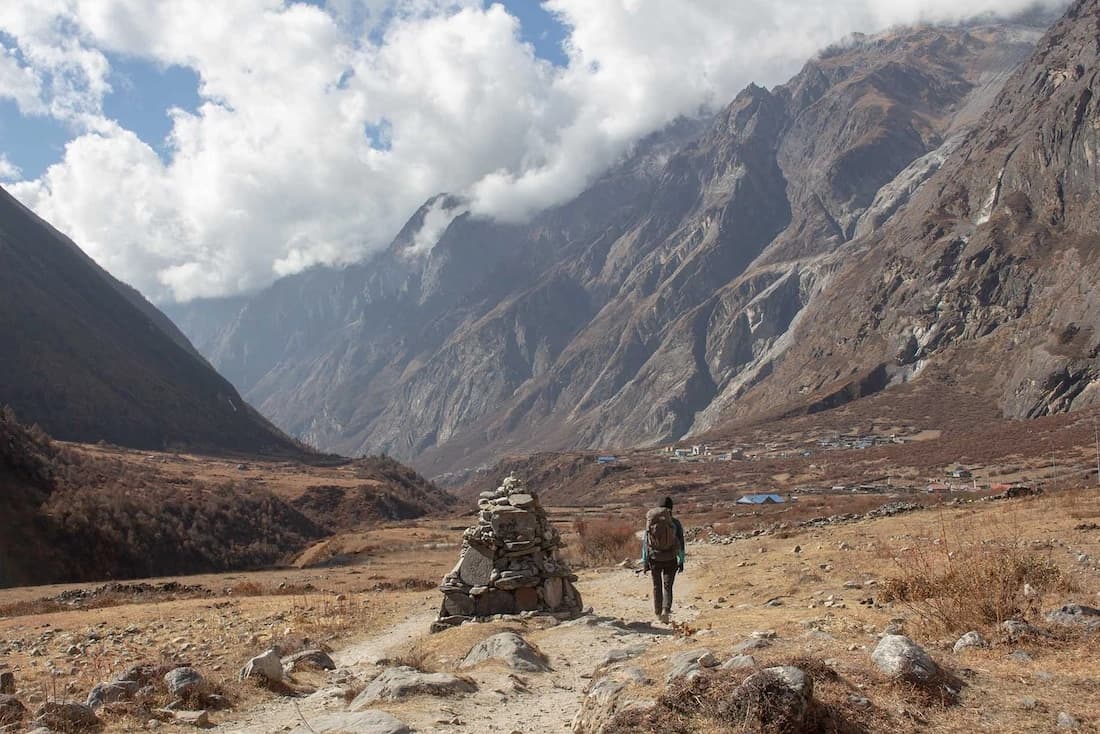Departure from Kathmandu
After breakfast at our hotel, we zoomed off in a small taxi towards the bus stop on the side of the north-west corner of Kathmandu’s main ring road. I was very excited but also thinking about our parents’ worries about us going off without a guide - it was the third week of November 2023 and the hiking season was coming to an end. Since we’d been here, the temperatures had definitely dropped by al least 10°C.
It was complete havoc at the bus stop. We were hurried to the ticket office, where about five different people were trying to get us the bus tickets from a man sitting in a tiny room squeezed between tea stalls. There were about twenty busses parked between dozens of fruit and veg sellers with people hurrying up and down, jumping on and off buses. The racket was no longer astonishing, as this was our 11th bus ride. This experience transitions from nerve-racking to, incredibly, a completely normal event—I feel rather nostalgic now as I’m writing this. It seemed like every bus was meant to depart at this time of day; all of the busses were parked along the side of the road, with no names, no destination signs, no numbers and no identification on your ticket either. But the locals, who are used to seeing foreigners completely lost, seemed willing to show us the way.

Our bus to Langtang
I love these buses; they may offer quite bumpy rides, but they never fail to surprise me. It could be the blaring music, the scenes both on the inside and outside, the unexpected forms of passengers—live or dead animals—or just the sensation of being close to death’s door at every bend. Whether it's the speed, the drop, the absence of a proper road, or perhaps all three, it all adds to the experience. For example, the road to Langtang provides a journey which truly tests you. You begin by climbing up the east side of the valley, only to gaze across and see the opposite side, scarred by landslides, knowing you're on similar terrain. We even spotted a few Nepalese people saying their prayers, which, somehow, didn’t make things better! I was thinking: “See, Mum, this is what you should really be worried about, not the hike.”
The bus journey to Langtang
We stopped in Trishuli Bazaar for dal bhat and bought some fruit from a street stall—a very good idea, as the only fruit we would see for the next week would be apples. Since the bus journey takes nine hours, we had to stay the night in Syabru Besi and set off the next morning. We were hosted by a woman and her daughter, who cooked us dal bhat for dinner and porridge with bananas and honey for breakfast. They asked us where we would be staying and handed us a stack of business cards for other tea houses owned by their family members.
As mentioned, the area is highly prone to landslides, something you start to notice during the second part of the bus ride from Trishuli Bazaar, where the road becomes very winding, with terrifying drops. Some people told us that if you look closely enough, you might spot one of the buses that didn’t make it (we didn’t see this ourselves).
Day one of the Langtang Valley Trek
Starting from Syabru Besi and making your way to Kyanjin Gompa, the path is in the shade of the mountains and only gradually gives way to wider part of the valley after Langtang Village. You walk along the Langtang Khola - which makes you feel cold just by looking at it - and pass through small groups of houses trying to not trip over the edge, but the scenery becomes more and more beautiful.
We stopped twice on our way to the top of the valley and spent the night at Ganesh Viewpoint (just before Lama Hotel) and the next at Morning View Guest House in Langtang. On our first day, we didn’t see many people, except for the French man we had spotted on the bus the previous day—I suddenly wondered how he must have felt during that journey. Pauline and I were both surprised by the number of French people we overheard while walking along—it almost felt like we were in the French Alps. Shortly after I shared this observation with Pauline, we came across a group of twenty to twenty-five Italians who had been visiting Nepal for years. They even brought along a 10-man moka pot! Classic.
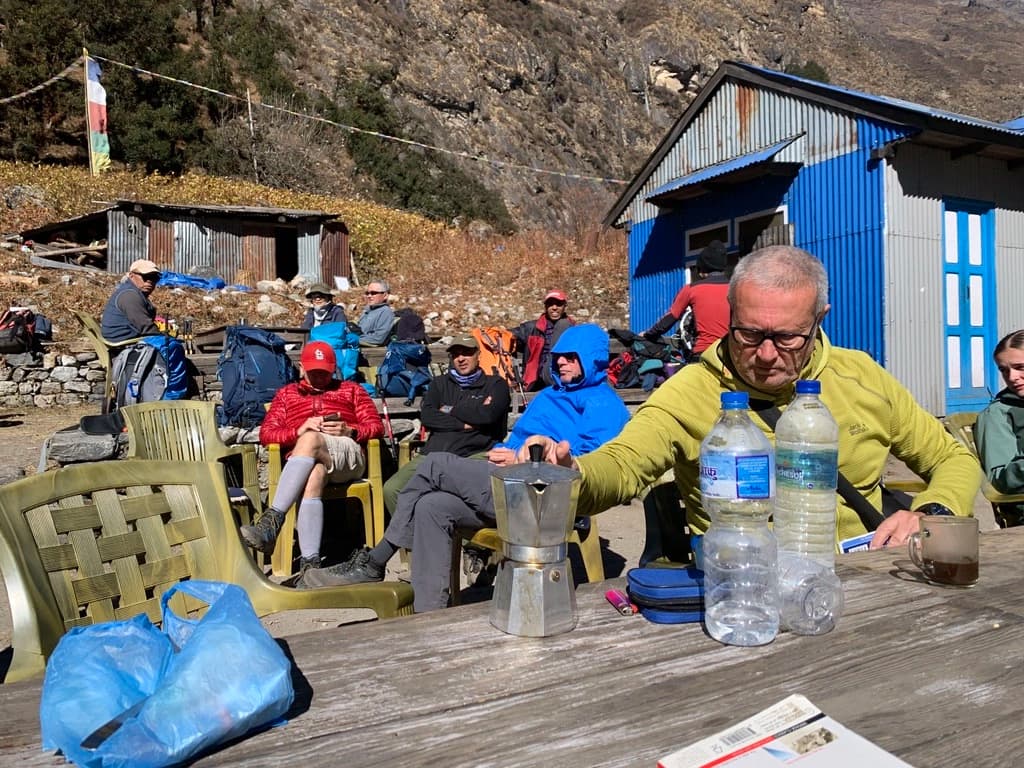
Italian Moka in Langtang
Ganesh Viewpoint is owned by a friendly young man who was a bit surprised that we had contacted him by phone to book a bed—we quickly discovered that this isn’t a common practice. However, we realised that we always seemed to get the nicest room. We managed to sit in the sun and soak up the last bit of warmth before the sunset. I had read online that Lama Hotel gets less sun and, as a result, is damper which can make you feel VERY cold in the evening and at night.
We both had dal bhat for dinner, which is brilliant when you’re hungry, as you’re offered second and third helpings. We sat in the wooden dining room, with benches along the walls covered in carpets and rugs, the flag of Tibet hanging in the corner and a lot of letters and cards from previous visitors. This was the first of many perfectly organised kitchens I would encounter. Thermoses, stainless steel trays and bowls all sat neatly on the wooden shelves, and a stove provided us with heat, dinner, and hot drinks.
The Langtang tea houses are very often lined with wood and have big warm kitchens and dining rooms with carpets and tables surrounding stoves with huge kettles on top. The dining rooms sometimes have a small shrine decorated with candles, incense and photos of the Dalai Lama or other monks.
Sea buckthorn juice is a speciality in Langtang Valley and is harvested only in June. It's known for its health benefits and is an important source of vitamins for the people who live in such a remote location. People say you should wait until you reach Kyanjin Gompa to taste the real drink—whether that’s true or not, I’m not sure. Sea buckthorn juice is always served hot.
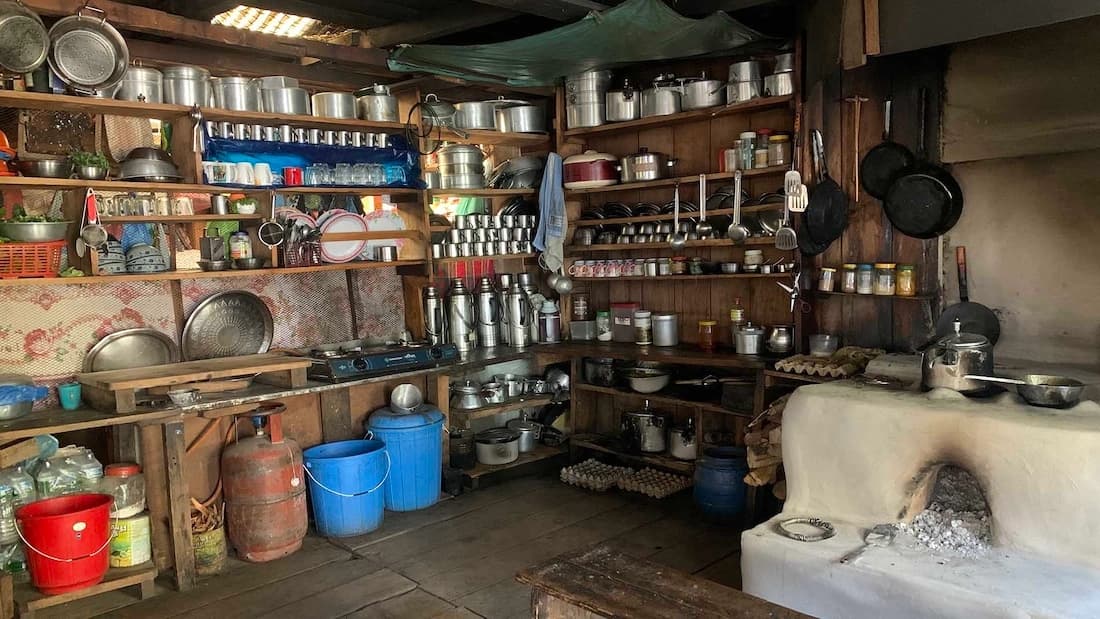
Ganesh Viewpoint's warm kitchen
We thought 150 rupees for a hot shower was a bargain we couldn’t refuse. However, my sleep wasn’t the most comfortable, as the rooms are all side by side, with walls made of wooden planks with quite a few gaps inbetween. I could have whispered to the person lying right next to me in the neighbouring room.
Day two
We started to spot Langtang Lirung, towering over 6,000 metres, hiding behind the mountains on the north side of the valley. As we walked, we passed hefty yaks, usually minding their own business, although we had been warned that they could be frisky. Perhaps it was the end of the season and they couldn’t be bothered with tourists anymore.
The yaks’ dry dung is collected in piles and used as firewood for the stoves. The naks, or female yaks, provide milk for making cheese—you can even visit the cheese factory in Kyanjin Gompa.
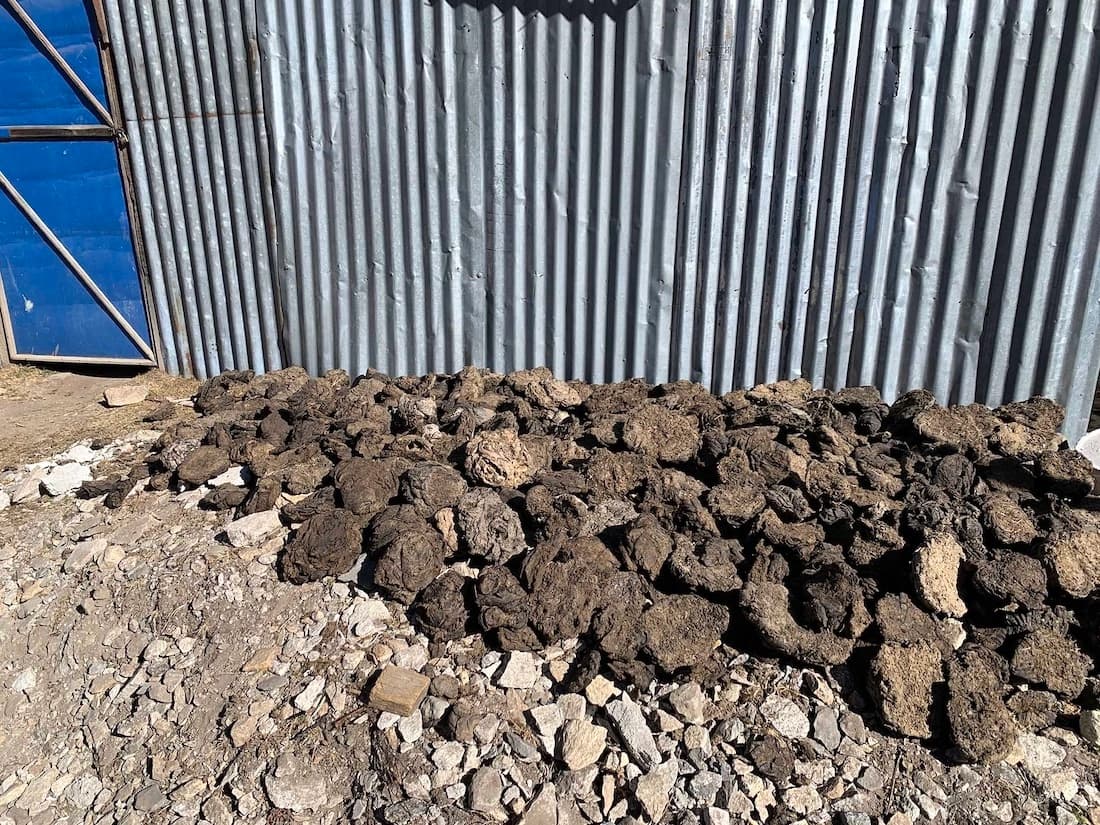
Yak and Nak poop collected and used for winter heating
The weather was clear, with not a breath of wind—apparently, the week before had been completely foggy the entire time. By the middle of the afternoon, clouds began to climb up the valley, but by then we were usually settled in our cosy tea houses. Unlike other hiking trails in Nepal, Langtang Valley has inhabited villages, which makes everything more comfortable. Most places offer hot showers and Wi-Fi.
Since there are no roads going up the valley (though a hydroelectric plant is now being constructed at its mouth), the villagers rely on mule caravans to bring in supplies, which go up and down the path every day. People living in the area have to order things two or three days in advance.
Always stay on the inside when you let mules pass as they might easily push you off the path!
Porters kept passing us, far fitter than we were, moving at twice our speed, if not triple. I’m still not sure whether hiring a porter to carry your gear is ethical or not.
We spotted a few langurs, who are clearly not welcome, as I was surprised to see a woman brandishing a slingshot to scare them away.
After having lunch with the Italians at Hotel Tibetan and being offered coffee, we continued our ascent. Although the steepest part was behind us, the altitude meant I had to stop every few yards to catch my breath.
Pauline’s love for pastry, and mine, made us stop at a bakery selling cinnamon rolls - this was the last thing I was expecting. In fact, I had happily prepared myself to eating Dal Bhat for the whole 8 days. After we settled in to Morning View guest house we sat on the wall outside to watch the sunset between the two mountain chains eating our cinnamon roll.
Women dressed in their chubas would come out of their houses to greet us, asking where we would be staying that night and whether we’d like to stay with them instead. Their smiles would usually fade when we mentioned that we already had a booking. Occasionally, we would pass people carrying dhokos, transporting a variety of goods.
We had been expecting to cross the Langtang landslide sooner or later that day, but when we finally reached it, the sheer size was astonishing—a whole slice of the mountain was missing. As you cross, there’s a gut feeling that you’re no match for nature.
The 2015 earthquake triggered the Langtang landslide, which killed over 200 people and annihilated Langtang Village, leaving many trapped in the upper part of the valley for days. This disastrous event not only resulted in significant loss of life but also toppled most of the trees, potentially leading to terrain issues in the future. Everyone was affected by this tragedy, and some hosts mentioned relatives who had died in the landslide.
I had read that the only place in the entire Langtang Valley that managed to escape complete destruction was Ghodā Tabela.
Day Three
As we walked through the valley, I felt incredibly small, like an ant dwarfed by the shockingly vertical mountains. The walk from Langtang Village to Kyanjin is relatively flat, but you pass through a few places, such as Mundu, which still has some original houses. You also pass the Mani wall and the memorial for those who died in the Langtang disaster. It’s customary to always stay to the left of these walls, much like walking around Nepal’s stupas clockwise.
Just before reaching Kyanjin Gumpa, we passed people carving prayer stones, known as Mani stones.
At the Hard Rock Café, we met a couple of people who convinced us to hike up Tsergo Ri (5033 m) instead of Kyanjin Ri (4773 m). They said it was the only way to truly feel as if you’re in the heart of the Himalayas. We would have tried to do both, but since we were a bit short on time, we preferred to focus on Tsergo Ri and a bit of the valley walk to Langshisha Kharka.
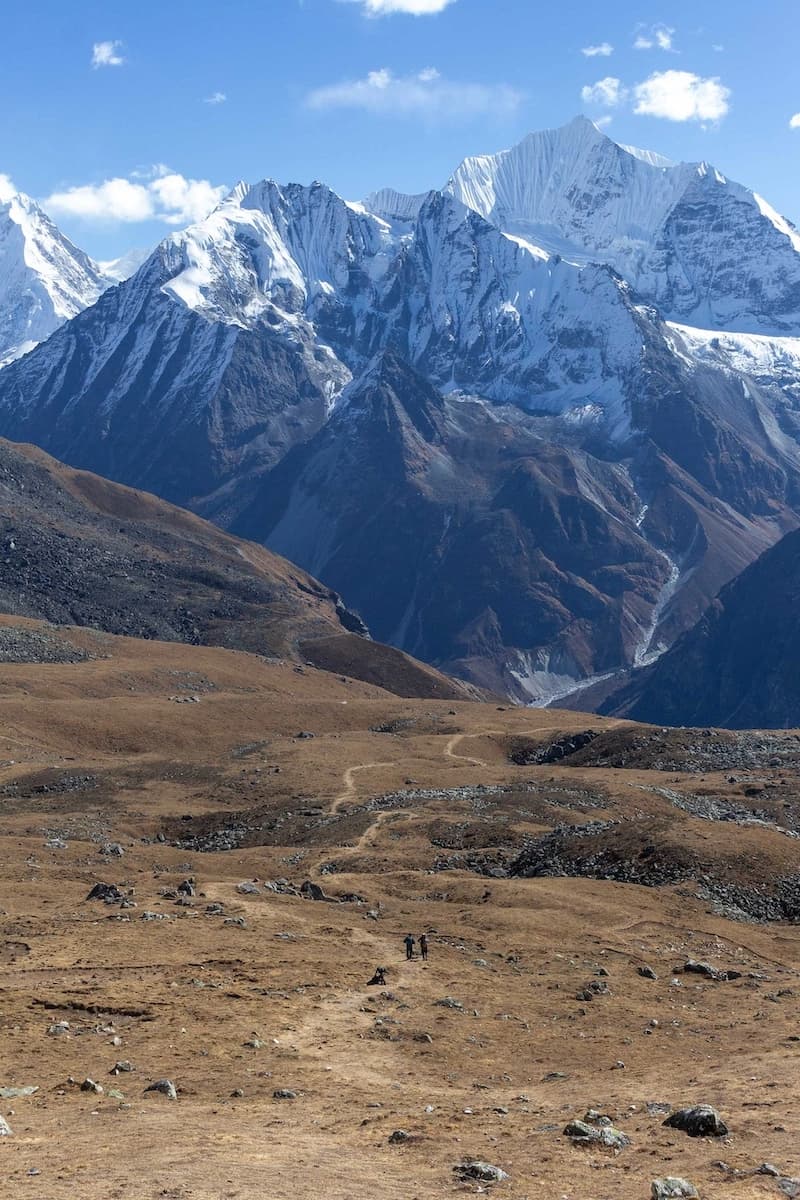
Tsergo Ri summit
Penba and Passan, two of five brothers, run Sunrise Guesthouse and make guests' stays truly enjoyable by offering helpful advice on hikes and timings, as well as providing great food. Many of the young people who work at the guesthouses only stay up here during the high season; when the temperatures drop and the hikers disappear, they return to Kathmandu. However, there are still many families who remain in the area year-round.
Tsergo Ri hike
Having done the Rinjani hike in Lombok, Indonesia, I was bracing myself for the worst, as Strava was showing similar data for the Tsergo Ri hike—about 1,200 metres of elevation gain in just 4 kilometres. Fortunately, the terrain here was not as sandy as the black volcanic slopes of Rinjani. On the morning we went up, the sky was clear, and there was no wind.
The walk was quite long and steep, but after navigating a stretch of black boulders, we reached the summit, where the prayer flags, known as lungta, were dancing in the wind. The people we had started our walk with had just arrived as well, and we all enjoyed the eggs and tea that Passan had prepared for us.
There are two ways to get back to the village: the loop or the way you came up. We opted for the loop, not realising that it would involve crossing numerous landslides, which made me slightly uneasy. However, the views and the colours of the landscape were even more stunning.
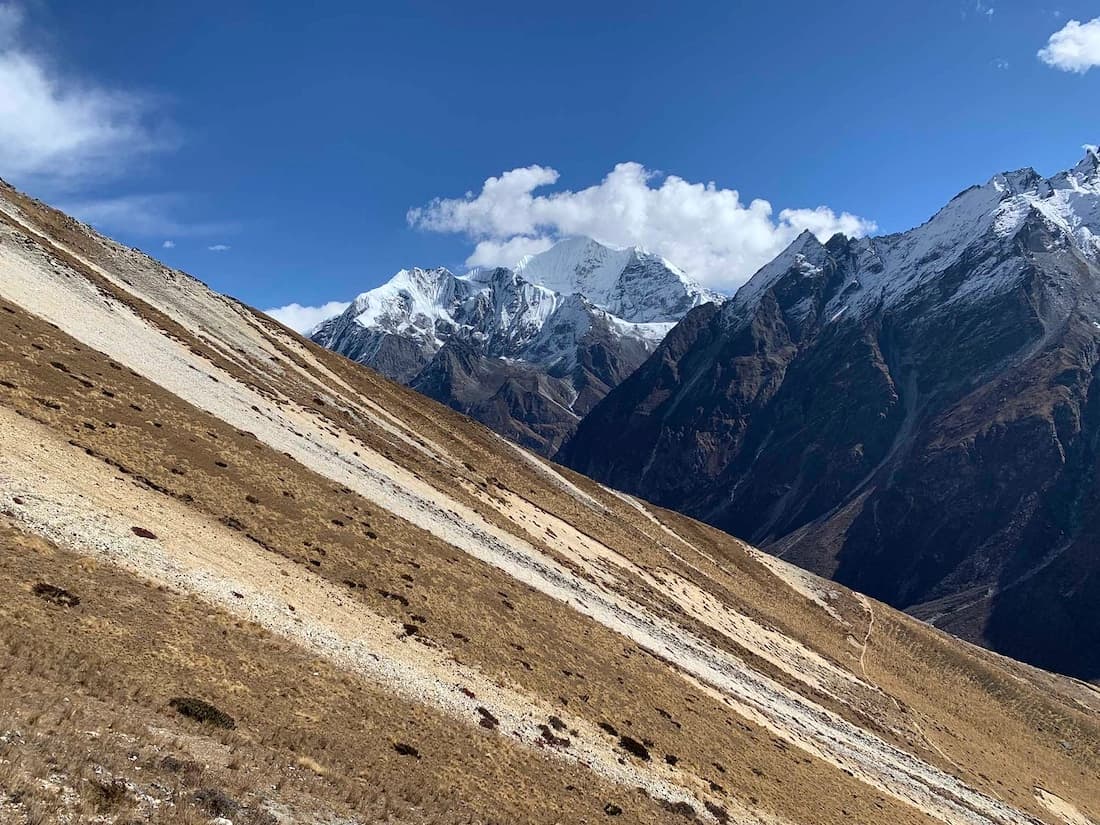
Landslides in the upper part of Langtang Valley
After about seven hours, we made it back to the village, where we headed straight to the bakery for some apple cake and apple pie. Although the apple pie is the most famous, I preferred the cake.
We met two Spaniards who were discussing their plans to reach Yala Peak and their adventure further up the valley. The valley walk to Langshisha Kharka is definitely worth considering, as it takes you to some of the most remote areas and allows you to experience the stars without any artificial light around.
Way down from Kyanjin Gumpa
We decided to try to make our way down in two days instead of three, allowing us to stay in Kyanjin an extra night. We also wanted to avoid staying in Syabru Besi, as we had seen nicer places along the way. So, we headed to Langtang View House, which the Spanish couple had recommended. We were the only guests that night, but we managed to spot a few Chyangra (Himalayan goats). The owners, a sweet middle-aged couple, made us porridge and coffee as we sat with them in the kitchen. They would hurry out whenever they saw passers-by, asking whether they needed any food or accommodation.
As we made our way back down the valley, I couldn’t help but feel a bit sad—this would be the last day of our trekking adventures, and my journey was also drawing to a close.
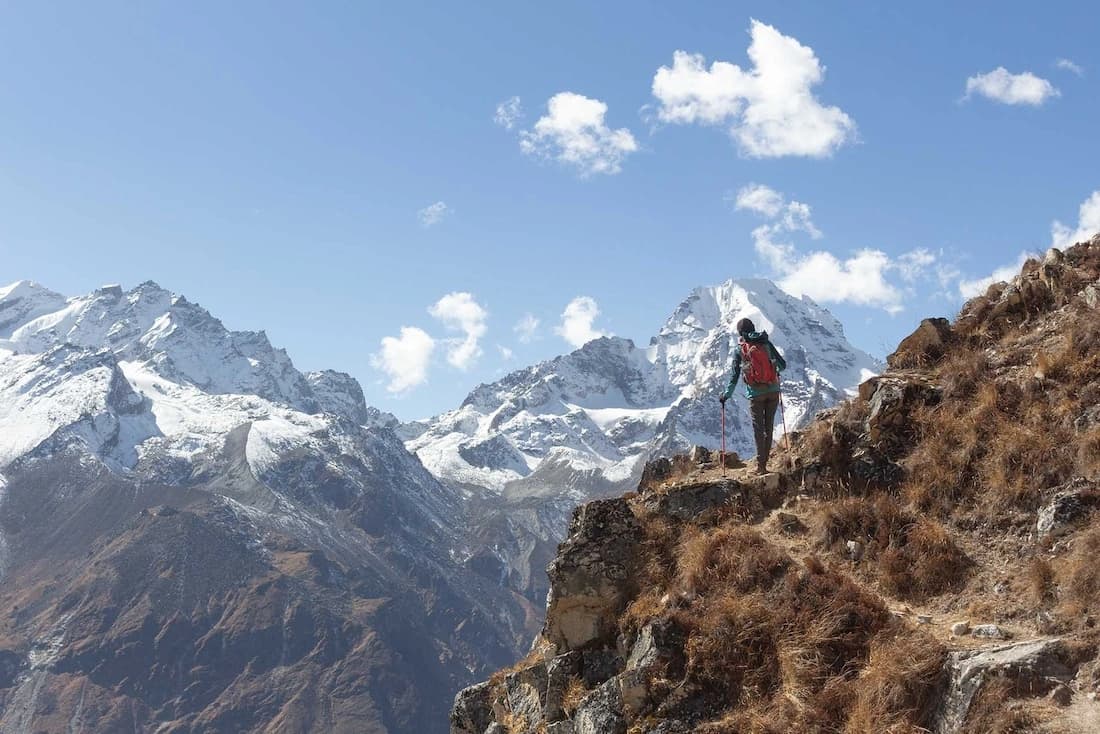
Hiking back to Kyanjin Gumpa from Tsergo Ri's summit
Conclusion
Going without a guide gave us the freedom to set our own pace and choose where to stay, allowing us to avoid Lama Hotel, which we wouldn’t have minded except that it’s right by the river and gets quite cold and damp just after lunchtime. The path is relatively easy up to Kyanjin Gompa; the only time I thought I might have preferred a guide was when descending from Tsergo Ri. We took the longer loop, and I felt uneasy crossing endless landslides on the paths. However, the good thing is that if you decide to go without a guide, it’s quite easy to find one once you’ve started, at any of the lodges.
